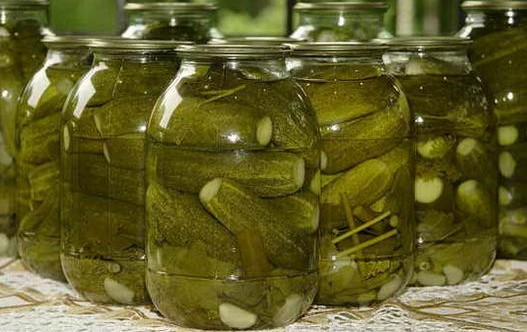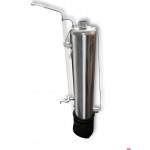
Preservation: How to Do It Right
Before refrigerators became commonplace, people balanced the "highs" and "lows" of harvests by preserving excess food for later use. One method of food preservation was canning. Most foods can only be safely canned at high temperatures and high pressure. That’s why canning in an autoclave is so popular.
The basic principle of canning is to kill all the microorganisms that spoil food, and then tightly seal the jar, preventing the entry of microflora. That’s why sterilization, cleanliness, and hygiene are so emphasized in canning.
How to Choose and Process Jars for Canning
Basic rules for preparing homemade preserves:
- Pathogenic microflora can develop inside a container with preserves, which can be harmful to health. This may not be externally visible, which is why it’s so important to sterilize jars before canning.
- Although glass jars are considered the optimal option, they can crack and break. Sometimes this happens right in the sealing process.
- The containers used for canning must be properly prepared. It is recommended to thoroughly wash the jars with hot water. It’s better to add a small amount of baking soda.
- It's best to heat jars evenly to prevent them from breaking. To do this, place a cloth napkin at the bottom of the pot where they are being sterilized.
- A whole glass jar makes a ringing sound when tapped with a pencil or wooden spoon. If there are cracks, the sound will be muffled.
- It’s better to use small jars of half-liter or liter capacity. In larger jars (3 liters), cucumbers and tomatoes will have less flavor and may soften.
- Plastic containers are not suitable for canning and pickling. Therefore, glass is the preferred option.
Plastic lids allow air to pass through, so they are not recommended for homemade canning. Metal lids sealed with a special machine should be used. They tightly seal the jars, preventing air from entering.
How to Pack Products and Seal Jars
Common products, such as eggplant or zucchini caviar, meat stew, or berry compote, simply need to be placed in containers, filling them almost to the top. It’s best to do this as quickly as possible to prevent air from entering. Then the filled jars are sealed with a lid.
Products to be pickled or salted are placed in the jar, then filled with brine. The jars should be sealed with a sterilized lid.
Once the product is packed and the jar sealed, it should be turned upside down. This allows the upper part of the jar, which is not filled, and the inside of the lid to be sterilized. The jars should remain in this position for at least 20-30 minutes.
Features of Storing Homemade Preserves
After the jars have cooled, they should be stored in a cool place without bright light. The recommended temperature is 14-16 degrees Celsius, and the air humidity should not be around 75%. Storing in the refrigerator is allowed if there is enough space. Usually, a cellar or basement is used for this.
It's important to prevent light from entering the room where the jars are stored. This is due to oxidative processes that are activated in plant products when exposed to light, which can lead to the development of microflora inside the jar.
By strictly following the recipe and preparation process, and adhering to the recommendations described above, the minimum shelf life of homemade preserves is 1 year. On average, stews, pickles, and marinades remain edible for 2-3 years, and sometimes longer.
Pasteurization and Sterilization – What’s the Difference?
"Pasteurization" refers to the method of food processing at relatively low temperatures of 80-100°C. Harmful microflora are destroyed by the high temperature, but beneficial biological components found in plant and animal products are preserved. Therefore, pasteurization is quite popular. However, the shelf life of pasteurized preserves is shorter than that of sterilized ones.
The essence of sterilization is similar to the previous method. The difference is in the higher temperature, above 100°C. The cooking duration is specified in the specific recipe chosen for the dish. To shorten the sterilization time, a special device - an autoclave - is used. It operates by applying high pressure, raising the boiling point of water to speed up the thermal processing of the preserves.
Popular Preserved Dishes
There are many options for preparing homemade preserves. The main thing is to follow the recipe to ensure delicious, long-lasting, and safe treats. However, all preserves can be divided into several categories:
- Meat and fish;
- Vegetables and fruits;
- Compotes and fruit drinks;
- Fermented foods.
Here are some recommendations for popular types of preserved dishes.
Pickles and Marinades

Salt is a natural preservative that protects products from the formation of bacteria, spores, and pathogens. Other preservatives are usually not used in home preservation. However, some additives, like dill or horseradish, may have slight preservative properties.
When pickling, preparations are filled with hot brine. After that, the jar should be turned upside down and left in this position until it cools at room temperature.
Cold brine can sometimes be used. In this case, the sealed jars should be sterilized along with the contents. It is not recommended to sterilize the jars for too long as useful vitamins are destroyed by prolonged heat exposure.
The main difference in marinades is the use of acetic acid as the primary preserving element instead of salt. The amount of acid should be added according to the recipe. It’s not advisable to use the common "by eye" method.
Products should be packed, jars sealed, and stored according to the same rules described earlier. Marinated preserves can be stored longer than pickles.
Meat Stew

Meat has a higher acidity level, making it more prone to spoilage. During oxidation, microorganisms develop rapidly. Therefore, storage rules must be stricter, and the canning process followed carefully.
Jars with meat stew should be sterilized for as long as possible. This usually takes several hours. The containers must be sealed exclusively with the use of a special machine. One should not ignore the rules and dosages described in the recipe; otherwise, the dish may be ruined.
Fermentation

Preservation during fermentation is achieved through salt and sugar. Both additives are strong preservatives, so sterilizing the container where the future dish is prepared is not necessary. Usually, a bucket or small barrel is used for fermentation, but a large jar is also suitable.
If you need to ferment a large amount of cabbage, adding acetic acid is allowed. It’s best stored in a place where the temperature does not exceed 10°C. It's important to ensure the cabbage remains submerged in the brine; otherwise, it can dry out or spoil prematurely.
Jams and Compotes

Depending on the recipe and the level of acidity of the berries or fruits used in preparation, storage methods for homemade jams may vary. Simply ground berries with sugar are hard to call jam. They are stored in the refrigerator for a relatively short period. To extend the storage time, they can be placed in the freezer, where they remain usable for 2-3 months, which is enough to enjoy them in winter.
If the berries were cooked for several hours, they can be stored even at room temperature. However, it is better to choose a cool room. Then, jars of sweet jam can last for 1-3 years. It's important to keep light from reaching the jars to prevent the stimulation of microorganism growth.
Compotes are stored under the same rules as pickles or marinades. There are no special rules for this type of homemade preserves. With proper storage and preparation, compotes can remain edible for several years.
Canning in an autoclave is one of the easiest and most effective ways to preserve products for a long time. In our catalog, you will find a large selection of autoclave models with different parameters. We operate throughout Ukraine, so you can order delivery to almost any settlement if necessary.
Our range includes not only autoclaves but also cheese makers, smokers, moonshine stills, and much more. All products are of high quality and durability.
Call us at (050) 376-60-86 or (067) 370-27-22 to place an order or clarify details. Our consultants will always help you choose the optimal device and provide comprehensive answers to your questions.
Also, read:
- Autoclave Operation Modes
- What is an Autoclave
- Hydraulic Testing of the Autoclave
- How to Use an Autoclave
- How to Choose an Autoclave









